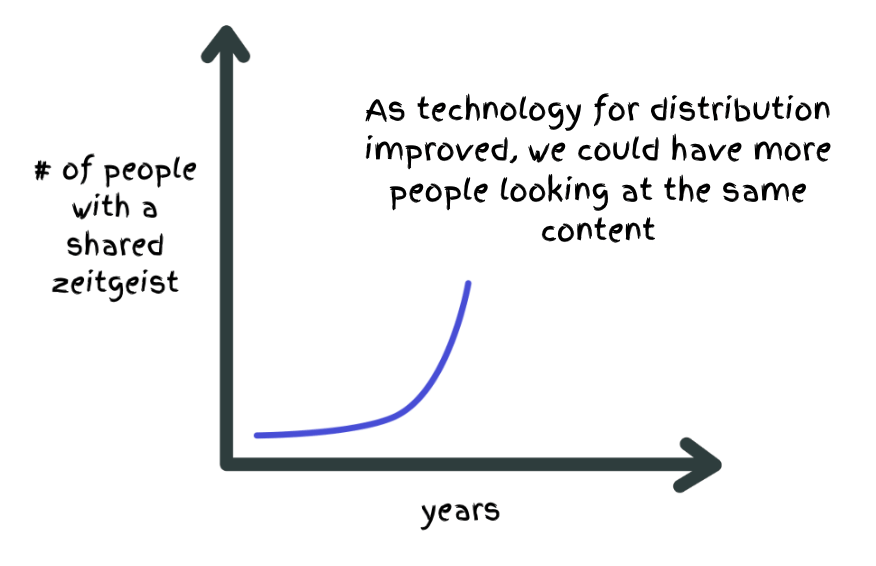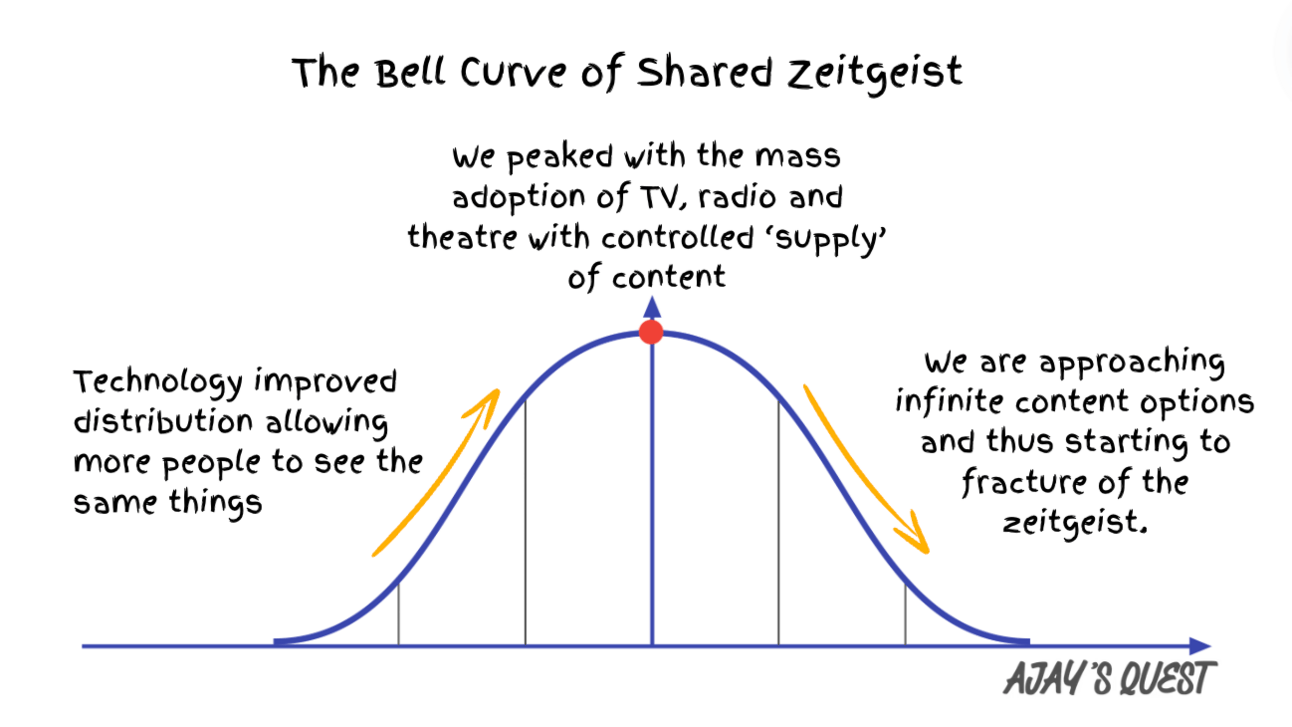- Ajay's Quest
- Posts
- Why Millennials are the Perfect Customer
Why Millennials are the Perfect Customer
I've been thinking about the shattering of the shared zeitgeist and what that means for consumers.
There will probably be nothing as culturally widespread as Harry Potter, Friends, Shrek etc. ever again.
Isn’t that crazy?
I wanted to explore why this is the case and here’s what I’ve come up with and also a little bit on why I think millennials are the gold mines of consumers right now.
By the way because I don’t want to be one of those people using big words to sound smart. Zeitgeist = what's going on culturally, religiously, or intellectually during a certain period.
The Rise of the Shared Zeitgeist
In the early days of media, distribution was the primary bottleneck preventing widespread knowledge of new content. Before TV and radio, most people learned about new stories, songs, or events directly from others, whether through word of mouth, local performances, or printed publications. This method of spreading information inherently had a slow proliferation rate. A book could only reach as many people as could afford to buy or borrow it, and local newspapers had limited circulation.
However, the advent of technologies like radio and television transformed this dynamic. Suddenly, media had a far broader reach, and its influence could span entire nations or even the world in an instant. TV and radio created an unprecedented platform for content distribution, allowing millions of people to consume the same shows, news, and entertainment simultaneously. This technological shift meant that everyone could watch the same TV shows in their living rooms or tune into the same radio programs at home or on the go. As a result, more people began to experience the same cultural moments, accelerating the creation of a shared zeitgeist.

By the 1970s and 1980s, TV had become a central medium for collective experiences. Limited channel choices meant a higher probability of large audiences tuning into the same programs. Shows like All in the Family, Cheers, and later Friends could regularly capture millions of viewers because they were among the few prime-time options available. This was the beginning of a media era in which shared cultural moments were at their peak.
Movies, too, found a way into this shared zeitgeist. Franchises like Star Wars became global events, with theatres serving as the gathering points where people shared the excitement and buzz of new releases. The emergence of blockbuster films transformed cinema into another collective experience, adding to the rise of the bell curve in shared cultural moments.
This era was marked by a kind of media monoculture: fewer channels, fewer shows, but a far-reaching impact. The proliferation of media through TV, radio, and cinema enabled society to rally around common stories and cultural touchstones, creating a unified cultural experience that defined generations. This growing interconnectedness of content consumption propelled the rise of the Shared Zeitgeist Bell Curve to its peak.
The Peak
The peak of the bell curve in shared zeitgeist was a hallmark of the 2000s, an era when TV shows, movies, and events captured the collective attention in a way that feels almost nostalgic in today’s fragmented media landscape. Back then, certain shows and cultural moments were so widely discussed that they became universal reference points, transcending age, geography, and background.
Take Friends, for example. Although it premiered in the 1990s, its peak influence extended well into the early 2000s, culminating in its finale in 2004. The finale drew a staggering 52.5 million viewers in the U.S. alone, making it one of the most-watched TV events of the decade. It wasn’t just a show; it was the show, creating characters and catchphrases that became ingrained in everyday conversation. Fans all over the world debated whether they were more like a Monica, a Rachel, or a Chandler, and the show’s impact on pop culture has been felt ever since.

Reality TV also hit its zenith in the 2000s with shows like American Idol. Premiering in 2002, the singing competition quickly became a nationwide obsession. At its peak, the show’s finale in 2003 attracted 38 million viewers, and the stars it created—like Kelly Clarkson and Carrie Underwood—went on to become household names. The show not only dominated TV ratings but also shaped popular music, sparking debates about talent, celebrity culture, and the American dream.
And let’s not forget the movie industry’s influence. The early 2000s saw the rise of Harry Potter and The Lord of the Rings franchises. Each new release became a global event, with fans lining up at midnight to catch the first screenings. The Lord of the Rings: The Return of the King (2003) alone grossed over $1.1 billion worldwide and swept the Oscars, winning 11 awards. Meanwhile, the Harry Potter films created a multi-billion-dollar franchise that shaped a generation, with book releases and movie premieres becoming communal experiences.
These moments were the peaks of the 2000s zeitgeist—cultural phenomena that brought people together, generated conversation, and became touchstones of the era. In a world that was beginning to embrace digital connectivity, they marked the last great wave of mass cultural experiences before media consumption began to fragment in the following decade.
Things I actually use 🚀
Here are a few recommendations or ways I can help you. Follow the links if any of these are interesting. (FYI - Using these links helps support the newsletter through a small kick back!)
🌍 Hiring Global Talent: Fine A+ players at lower costs with Athyna
👨🎨 Get Unlimited Design Work: Want great designs at a low monthly cost? Try ManyPixels
📰 Build a Newsletter: Want to build a newsletter like me? Try Beehiiv
The Fall: Media Fragmentation
As the 2000s came to an end, the peak of shared cultural experiences began to wane, giving way to a new era defined by media fragmentation. The rise of the internet, social media, and on-demand streaming services transformed how we consumed content. While this ushered in a golden age of variety and choice, it also marked the decline of those massive, unified moments in the cultural zeitgeist.
In the early 2000s, television was still dominated by a handful of networks, and cable packages were the norm, ensuring that most people had access to a similar range of shows. However, the rapid adoption of broadband internet and the birth of platforms like YouTube (founded in 2005) signalled a shift. Suddenly, anyone could upload content, and everyone had the freedom to choose from an endless array of videos, vlogs, and niche content creators. This explosion of variety was liberating, but it also splintered audiences into countless smaller communities.
The fragmentation deepened with the emergence of on-demand streaming services. When Netflix introduced its streaming service in 2007, it set off a chain reaction that forever altered viewing habits. No longer did audiences have to tune in at a specific time or rely on a network’s schedule; they could now binge entire seasons at their convenience. The “Netflix effect” changed how stories were told and consumed. Series like Stranger Things and House of Cards found devoted fan bases, but the audience was often scattered, watching on their own timelines, which diluted the sense of collective participation that shows like Lost and Friends had once commanded.
Social media further fractured the shared experience. Platforms like Facebook, Twitter, and later Instagram and TikTok, became the new gatekeepers of content. These networks’ algorithms quickly learned users' preferences, creating echo chambers of tailored content. Instead of a few universally popular shows or movies, there was now an endless stream of niche interests, viral trends, and micro-communities. Even when something went viral, it often did so within specific circles, leaving others unaware. The days of universally recognised cultural references were fading.

This fragmentation wasn’t limited to just TV and movies. Music consumption also evolved with the arrival of streaming platforms like Spotify and Apple Music. Where the radio and MTV once pushed a relatively narrow selection of chart-topping hits into the mainstream, these platforms now allowed listeners to explore endless genres and artists. As a result, the “song of the summer” or the “album of the year” became less definitive, as audiences curated their own unique playlists, tailored to individual tastes.
While media fragmentation has given us more control and personalised experiences, it has also made the shared cultural moments of the past increasingly rare. Today, it’s unlikely that a TV show finale will attract 50 million viewers or that a new album will be dissected by nearly everyone at the same time. In the digital age, the fall of the unified cultural peak has led to a more diverse but divided media landscape.

Millennials: the ones who lived through the Peak
Millennials hold a unique place in cultural history. As the generation that lived through the height of shared zeitgeist moments in the 1990s and early 2000s, they experienced the last era of unified pop culture before media fragmentation took over. Whether it was the collective craze over Harry Potter, the frenzy of Pokémon cards, or the anticipation of Friends’ final season, millennials were part of some of the most significant cultural moments that defined an entire generation. This shared experience has made them one of the most cohesive and targetable demographics, giving brands and creators a common touchpoint for products, marketing, and nostalgia.
Because millennials collectively consumed the same content in real time, they share a vast bank of common experiences and cultural references, creating a demographic marked by conformity and shared nostalgia.
This shared cultural foundation makes it relatively easier for companies to create products and marketing campaigns that resonate with millennials. Brands know that invoking these peak moments can evoke strong emotional responses, leading to a surge of nostalgia-based products and media in recent years. We see this in the resurgence of everything from ‘90s-inspired fashion to TV show reboots. The entertainment industry, in particular, has doubled down on tapping into this nostalgia.
The Barbie movie (2023) is a perfect example of this phenomenon. Mattel took an iconic toy that dominated millennial childhoods and reimagined it for modern audiences, blending nostalgia with a contemporary twist. The movie became a cultural event, grossing over a billion dollars and sparking a worldwide conversation.
Similarly, franchises like Marvel have leveraged the millennial audience through sequels, spin-offs, and character reboots. Movies like Avengers: Endgame broke box office records, partly because they tapped into years of comic book fandom and nostalgia for characters introduced in the early 2000s. Even Disney has cashed in by remaking its classic animated films like The Lion King, Aladdin, and Mulan into live-action adaptations, banking on the millennial generation’s fond memories of the originals.
Streaming services have also jumped on the nostalgia train, with shows like Stranger Things using 1980s and 1990s references as a core part of their appeal. Meanwhile, companies are reviving classic gaming consoles like the NES Classic and PlayStation Classic, allowing millennials to relive their childhood gaming experiences.
This wave of nostalgia isn’t just limited to entertainment. Brands like Tamagotchi, Polaroid, and even fashion companies have resurrected products with a vintage twist, aiming directly at millennials who long for the simplicity of their formative years. Marketers understand that this demographic's shared experience of the "peak" years makes it easier to build campaigns that resonate, creating a sense of familiarity and belonging.
In essence, millennials are the last generation to experience these shared cultural peaks, making them an attractive target for products and services that play on nostalgia. Their conformity, rooted in these collective experiences, has become a powerful tool for companies seeking to create a deep emotional connection with their audience. As long as the millennial desire to revisit their peak moments persists, brands will continue to ride this wave of nostalgia to capture their hearts—and their wallets.
Would love to know what you thought of this article. I’m trying to write more these days so feedback is always appreciated. Hit reply and i’ll always reply back.
Cheers,
Ajay